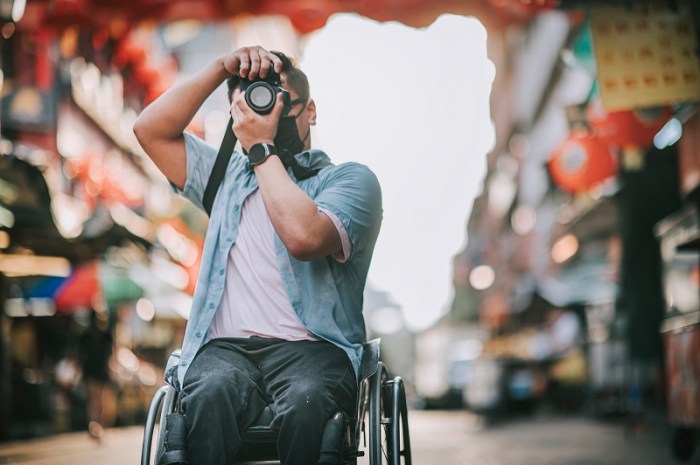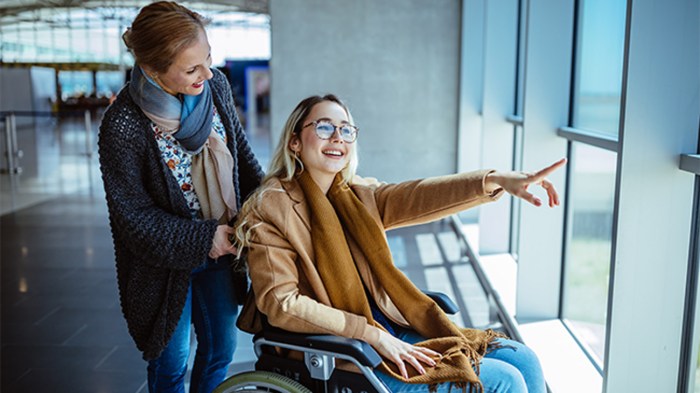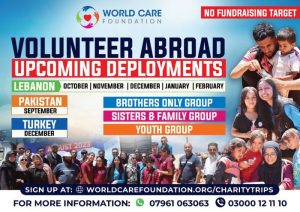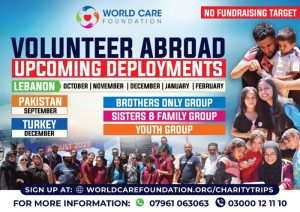
Traveling with a disability: Embarking on a journey while managing a disability presents unique challenges, but also incredible rewards. This guide explores the practicalities and possibilities of accessible travel, from meticulously planning your trip to discovering hidden gems along the way. We’ll delve into finding suitable accommodations, navigating transportation, and maximizing your travel experience regardless of physical limitations.
This comprehensive resource aims to empower individuals with disabilities to confidently explore the world, offering practical advice, insightful tips, and valuable resources to ensure a smooth and enjoyable travel experience. We’ll cover everything from researching accessible destinations and booking accommodations to communicating your needs effectively and making the most of your journey.
Accessibility in Transportation

Navigating the world with a disability often requires careful planning and consideration of accessibility features in various modes of transportation. This section explores the accessibility provisions offered by different travel options, highlighting both positive aspects and areas needing improvement. Understanding these nuances can significantly enhance the travel experience for individuals with disabilities.
Airline Accessibility Features
Major airlines generally offer a range of services for passengers with disabilities. These typically include wheelchair assistance at airports, priority boarding, and the provision of special meals. Many airlines also allow passengers to bring necessary medical equipment onboard, often free of charge. Specific features and policies vary considerably between airlines and even between flights, so it’s crucial to contact the airline directly well in advance of travel to confirm the availability of required services and make necessary arrangements.
For example, some airlines offer pre-boarding assistance and dedicated seating areas for passengers needing extra space or assistance. However, inconsistencies in the implementation and availability of these services across different airlines and routes remain a significant challenge.
Train Travel Accessibility: A Global Comparison
Accessibility in train travel varies significantly across countries. The following table summarizes accessibility features and limitations in select countries. Note that this is not an exhaustive list and specific accessibility features can change over time.
| Country | Train Type | Accessibility Features | Limitations |
|---|---|---|---|
| United States | Amtrak | Wheelchair-accessible cars, ramps, elevators at some stations, accessible restrooms on some trains. | Inconsistency in accessibility across different routes and stations, limited availability of accessible restrooms, potential challenges with boarding and disembarking on older trains. |
| United Kingdom | National Rail | Generally good accessibility on newer trains, step-free access at many stations, accessible restrooms on many trains. | Older trains may have limited accessibility, some stations still lack step-free access, potential issues with navigating crowded platforms. |
| Japan | Shinkansen (Bullet Train) | Excellent accessibility, dedicated wheelchair spaces, ramps, elevators at most stations, clear signage. | Limited English signage in some areas, potentially high cost for assistance services. |
| Germany | Deutsche Bahn (DB) | Generally good accessibility on newer trains, ramps, elevators at many stations, accessible restrooms. | Older trains may have limited accessibility, some smaller stations may lack accessibility features, potential issues during peak travel times. |
Cruise Ship Accessibility Standards
Cruise lines are increasingly focused on improving accessibility for passengers with disabilities. Many offer wheelchair-accessible cabins with wider doorways and roll-in showers. Onboard facilities often include accessible restrooms, elevators, and pools. Shore excursions are also increasingly being adapted to accommodate passengers with disabilities, though advance booking and communication with the cruise line are crucial. However, the accessibility of specific features can vary greatly between cruise lines and ships, and it is vital to review accessibility information provided by each cruise line before booking.
For instance, some cruise lines provide accessible tenders and wheelchairs for use during shore excursions. Others may offer modified shore excursions tailored to the needs of passengers with disabilities.
Challenges and Solutions for Road Trips with Disabilities
Road trips present unique challenges for individuals with disabilities. These can include difficulties finding accessible restrooms, navigating uneven terrain, and securing accessible accommodations along the route. Careful planning is key. This involves researching accessible routes, booking accessible hotels in advance, and bringing necessary medical supplies and assistive devices. Utilizing GPS navigation systems with accessibility features, like identifying accessible restrooms along the route, can greatly enhance the journey.
Furthermore, consider renting a vehicle with features suited to specific needs, such as hand controls for drivers with limited mobility or a vehicle with a ramp for wheelchair users. Pre-planning rest stops and overnight stays, factoring in potential delays due to accessibility challenges, is also critical for a successful road trip.
Unique Stays and Treehouses

Stepping outside the traditional hotel experience offers a wealth of unique accommodation options, many of which are increasingly incorporating accessibility features. Treehouses, cabins, and other nature-immersive stays are becoming more inclusive, catering to a wider range of travelers’ needs. This section will explore the accessibility considerations involved in these unique accommodations and highlight examples of accessible options.
The accessibility of unique stays, such as treehouses and cabins, varies significantly depending on the specific property and its design. While many are inherently challenging to make fully accessible due to their location and structure, innovative designs and thoughtful planning are increasingly overcoming these obstacles. Key accessibility features to look for include ramps, wider doorways, adaptable bathrooms, and accessible pathways.
Accessible Treehouse Features
Many accessible treehouses prioritize ease of access to the main structure. This often involves ramps leading up to the treehouse platform, eliminating the need for stairs. Inside, wider doorways allow for wheelchair access, and grab bars are installed in bathrooms to provide additional support. Some treehouses incorporate roll-in showers or adaptable bathrooms with adjustable height vanities and toilet seats.
Finally, level pathways leading to the treehouse and surrounding area ensure independent mobility for guests with mobility devices. It’s important to note that these features may not be standard in all treehouses, so careful research and direct communication with the property is crucial.
Examples of Accessible Unique Stays
Several companies and resorts specialize in providing accessible unique accommodations. While specific features vary, these often include cabins and treehouses designed with wheelchair access in mind. Imagine a secluded cabin nestled amongst the trees, featuring a ramp leading to the front door, a spacious bathroom with a roll-in shower, and wide hallways to navigate with a wheelchair or other mobility devices.
Another example could be a treehouse platform built at a lower height to the ground, eliminating the need for extensive ramps, with carefully planned pathways to the surrounding natural environment. These accommodations often incorporate features to minimize environmental barriers while maximizing independence for guests with disabilities. Remember to always check the individual property’s accessibility details before booking.
Houseboat and Yacht Stays
Houseboats and yachts offer a unique and potentially luxurious travel experience, but accessibility for individuals with disabilities can vary significantly. While some vessels boast impressive accessibility features, others may present significant challenges. Understanding these differences is crucial for planning an inclusive and enjoyable trip.
The accessibility of houseboats and yachts is largely dependent on the specific vessel and the company providing the rental. Factors such as the age of the boat, its design, and the modifications made for accessibility play a major role. While some newer vessels are built with accessibility in mind, older ones may lack essential features. Similarly, rental companies vary widely in their commitment to providing accessible options.
Accessibility Features in Houseboats and Yachts
Many modern houseboats and yachts are now being designed and retrofitted with accessibility features to cater to a wider range of travelers. These can include features like ramps for easier boarding, wider doorways and hallways for wheelchair access, accessible bathrooms with grab bars and roll-in showers, and adaptable sleeping arrangements. Some vessels even offer specialized lifts or hoists for transferring between decks.
However, the availability of these features is not consistent across all rentals.
Challenges and Considerations for Travelers with Disabilities
Even with accessible features, several challenges remain for travelers with disabilities on houseboats and yachts. Navigation on a boat can be challenging, especially for those with mobility impairments. Uneven surfaces, narrow walkways, and the constant movement of the vessel can pose safety risks. The availability of accessible restrooms and showering facilities in marinas and harbors also needs to be considered, as these are not always guaranteed.
Additionally, the level of support available on board should be assessed, including the availability of assistance with tasks like transferring and mobility. Emergency procedures and evacuation plans should also be reviewed for accessibility.
Examples of Accessible Houseboat and Yacht Rentals, Traveling with a disability
Finding specific examples of accessible houseboat and yacht rentals requires direct inquiry with rental companies. Many companies do not explicitly advertise accessibility features on their websites. It is crucial to contact rental providers directly and inquire about specific accessibility features relevant to your needs. This includes detailed questions about ramps, doorways, bathroom facilities, sleeping arrangements, and emergency procedures.
Look for companies that have a demonstrable commitment to inclusivity and are willing to work with you to ensure a comfortable and safe experience. Be prepared to provide details of your specific accessibility needs to help them assess the suitability of their vessels.
Ultimately, traveling with a disability is achievable and rewarding. With careful planning, resourcefulness, and the right information, you can create unforgettable memories while experiencing the world on your own terms. Remember to embrace flexibility, advocate for your needs, and focus on the joy of exploration. The world is waiting to be discovered, and with the right preparation, it’s accessible to everyone.
Key Questions Answered: Traveling With A Disability
What travel insurance is best for travelers with disabilities?
The best travel insurance depends on your specific needs and the nature of your disability. Look for policies that offer comprehensive coverage for medical emergencies, trip cancellations, and lost or damaged equipment. Some insurers specialize in travel insurance for people with disabilities, so comparing policies is essential.
How can I find accessible transportation at my destination?
Research public transportation options in advance. Many cities offer accessible bus and train services. Consider using ride-sharing apps with accessibility features or pre-booking accessible taxis. Look for information on local accessibility services or tourist information websites.
What should I do if I encounter accessibility issues during my trip?
Document the issue with photos or videos. Contact the relevant service provider (airline, hotel, etc.) immediately to report the problem and seek a resolution. If the issue remains unresolved, consider contacting a consumer protection agency or disability advocacy group.





